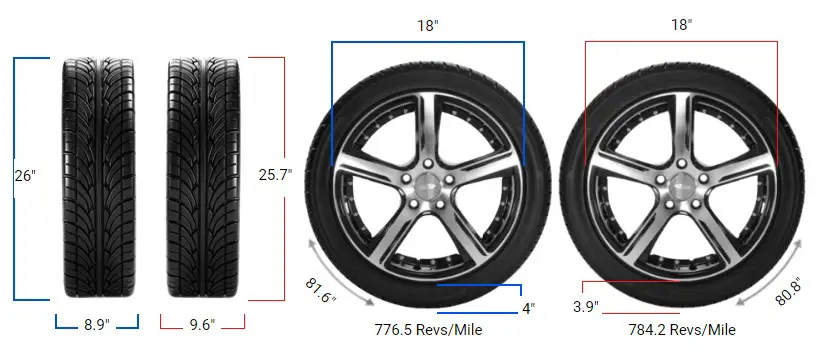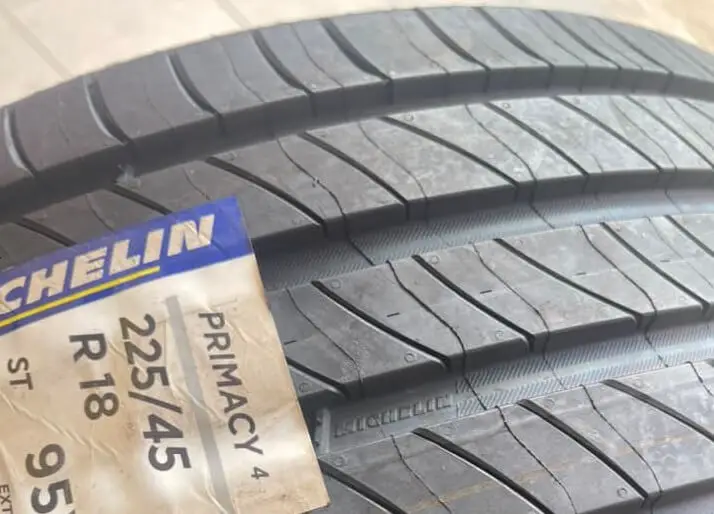Tire Size 225/45r18 vs 245/40r18

Tire upgrades can enhance your vehicle’s performance and look. Let’s explore the switch from 225/45r18 to 245/40r18 tires, examining how this change impacts your ride both on and off the road.
- The new tires are 8.9% wider, improving grip and stability.
- Overall diameter decreases by 1%, within the safe range for fitment.
- Sidewall height reduces by 3.2%, potentially affecting ride comfort.
- Speedometer accuracy changes slightly, showing about 0.2 mph slower at 20 mph.

Fitment Guide
It’s crucial to stay within the ±3% range for overall diameter to ensure proper fitment. In this case, the diameter difference is only -1%, well within the acceptable range.
This means the switch from 225/45r18 to 245/40r18 is generally safe and shouldn’t require any major modifications to your vehicle.
On-Road Impact
The switch to 245/40r18 tires can noticeably affect your on-road driving experience. Let’s break down the key areas of impact:
- Handling & Grip: The wider tires (8.9% increase in width) provide a larger contact patch with the road. This extra rubber on the ground can significantly improve traction, especially during cornering and in wet conditions. You may notice enhanced stability and more confident handling, particularly at higher speeds.
- Ride Comfort: The lower profile tires (3.2% decrease in sidewall height) might lead to a slightly firmer ride. With less rubber to absorb road imperfections, you may feel more bumps and vibrations. However, this change is relatively small, so the impact on comfort should be minimal for most drivers.
- Speedometer Accuracy: The 1% decrease in overall diameter will affect your speedometer readings slightly. At 20 mph, your actual speed will be about 19.8 mph. This difference is minor and likely won’t cause any significant issues in daily driving.
- Gas Mileage: The wider tires may create slightly more rolling resistance, potentially leading to a small decrease in fuel efficiency. However, given the minimal change in overall diameter, this effect should be negligible for most drivers.
- Aesthetics: The wider, lower-profile tires can give your vehicle a sportier, more aggressive look. This change is often seen as visually appealing and can enhance the overall appearance of your car.

Off-Road Impact
While the switch to 245/40r18 tires is more commonly associated with on-road performance, it can also affect off-road capabilities:
- Ground Clearance: The 1% decrease in overall diameter will lower your vehicle’s ground clearance by about 0.13 inches (3.25 mm). This change is minimal and unlikely to significantly impact your off-road performance in most situations.
- Traction: The wider tires can provide better traction on loose surfaces like gravel or sand. However, in mud or deep snow, the wider tires might be more prone to floating on top rather than digging in for grip.
- Durability: The lower profile tires may be slightly more susceptible to damage from rocks or rough terrain. If you frequently drive off-road, you might need to be more cautious to avoid potential tire damage.
- Water Fording: The slight decrease in overall diameter might marginally reduce your vehicle’s water fording depth. However, this change is so small that it’s unlikely to make a noticeable difference in most situations.

What is the Difference Between 225/45r18 and 245/40r18?
The main difference between 225/45r18 and 245/40r18 tires lies in their width and profile. The 245/40r18 tire is significantly wider, with an 8.9% increase in width compared to the 225/45r18.
This wider footprint provides a larger contact patch with the road, potentially improving grip and handling. However, this comes with a lower profile sidewall, as the 245/40r18 has a 3.2% decrease in sidewall height.
This combination of wider tread and lower profile can result in noticeable changes in vehicle performance and appearance.
Can I Use 245/40r18 Instead of 225/45r18?
Yes, you can use 245/40r18 tires instead of 225/45r18. The overall diameter difference between these two tire sizes is only -1%, which falls well within the recommended ±3% range for safe tire fitment.
This small difference means that the switch should not cause any significant issues with your vehicle’s performance or safety systems.
However, keep in mind that the wider tires may affect handling characteristics and potentially impact fuel efficiency slightly.

How Much Taller Is A 245/40r18 Tire Than A 225/45r18?
Actually, the 245/40r18 tire is not taller than the 225/45r18 tire – it’s slightly shorter. The data shows that the 245/40r18 tire has a diameter of 25.72 inches (653.2 mm), while the 225/45r18 tire has a diameter of 25.97 inches (659.7 mm).
This means the 245/40r18 tire is 0.26 inches (6.5 mm) shorter than the 225/45r18 tire, representing a -1% difference in overall height.
How Much Wider is a 245/40r18 Tire Than a 225/45r18?
The 245/40r18 tire is 0.79 inches (20 mm) wider than the 225/45r18 tire. Specifically, the 245/40r18 tire has a width of 9.65 inches (245 mm), while the 225/45r18 tire has a width of 8.86 inches (225 mm).
This represents an 8.9% increase in width, which is a significant difference that can noticeably affect the tire’s contact patch with the road and potentially improve traction and handling characteristics.
Our Observation
Switching from 225/45r18 to 245/40r18 tires offers several benefits, including improved handling, better traction, and a sportier appearance. The wider tires provide a larger contact patch, enhancing grip and stability, especially during cornering and in wet conditions.
However, this change also comes with some potential drawbacks, such as a slightly firmer ride due to the lower profile and a minor impact on fuel efficiency.
The effects on off-road performance are generally minimal, with only slight changes in ground clearance and traction characteristics.
Overall, this tire switch is well-suited for drivers prioritizing on-road performance and aesthetics, with negligible impact on off-road capabilities for occasional light off-road use.

Meet Caitlin McCormack, a Tire Size Expert and Blogger Passionate About Everything Related to Tires. With Years of Experience in the Tire Industry, Caitlin Has Become an Expert in Tire Sizes and Their Impact on Vehicle Performance.
